What are coordinating conjunctions? In the English language, a conjunction is a word that connects other words or sets of words in a sentence. Coordinate conjunctions or coordinating conjunctions are a type of conjunction that joins sentences, words, phrases, and clauses together.
What is a coordinating conjunction?
Coordinating conjunctions join elements that are of equal syntactic importance and grammatical rank. These can be two nouns, two verbs, two adjectives, two main clauses, or two phrases.
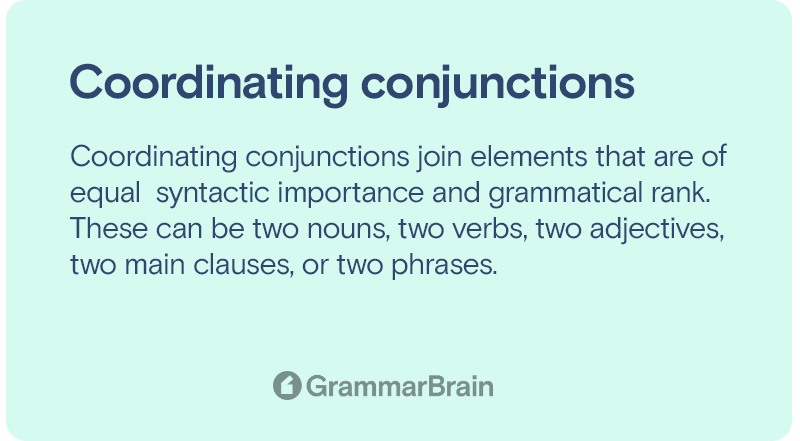
Coordinating conjunctions: The different types
Coordinating conjunctions can be divided into four broad categories depending on the purpose they serve in a sentence.
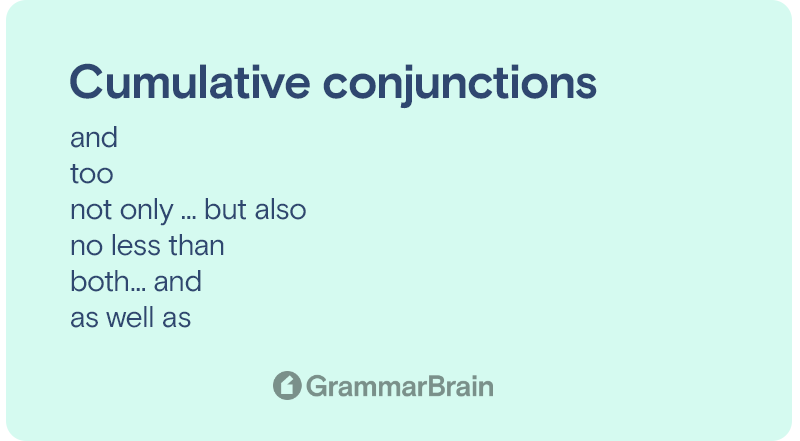
Cumulative conjunctions
These conjunctions can be used to join a word, phrase, or sentence with another. These words can be used to join similar types of things together. They can also be swapped out for other conjunctive terms from the same group. Cumulative conjunctions include:
- and
- too
- not only … but also
- no less than
- both… and
- as well as
Examples:
- Brian understands English and French.
- Brian understands both English and French.
- Brian understands not only English but also French.
- Brian understands English and French too.
- Brian understands English no less than French.
- Brian understands English as well as French.
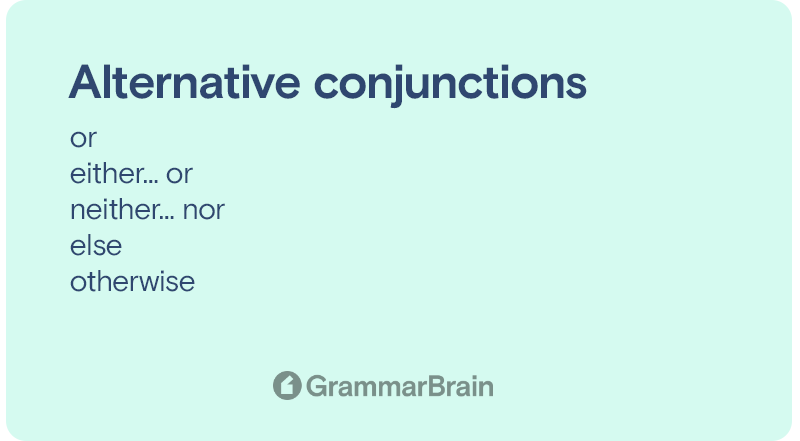
Alternative conjunction
Alternative conjunctions present or connect alternative things or ideas. They present different options of the same thing to the reader as choices. Alternative conjunctions include:
- or
- either… or
- neither… nor
- else
- otherwise
Examples:
- Brian or Sarah are coming to the party.
- Brian will either drink tea or eat a pizza.
- Neither Brian nor Sarah is coming to the party.
- I got the package delivered today; else I would have gone to the supermarket.
- Brian had to go to the party; otherwise, he would have studied for the test today.
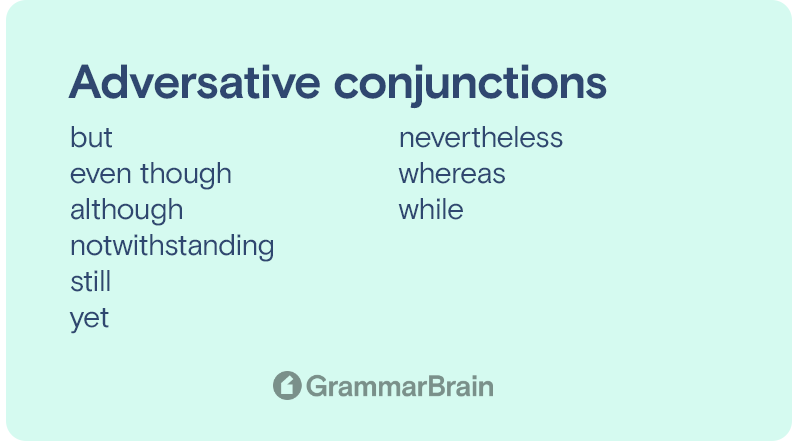
Adversative conjunction
Conjunctions of this kind are used to highlight opposing viewpoints or statements. are employed in sentences to indicate disapproval, disagreement, or refusal. Adversative conjunctions include:
- but
- even though
- although
- notwithstanding
- still
- yet
- nevertheless
- whereas
- while
Examples:
- Brian stumbled on the road, but he did not fall.
- Lily failed the competition even though she prepared for it.
- Norah was depressed and miserable, although she was wealthy.
- Brennan is diabetic, notwithstanding that he eats chocolate.
- James deceives Sarah in every competition, but she still trusts him.
- Lola was harsh to the kids, yet I believe she means well.
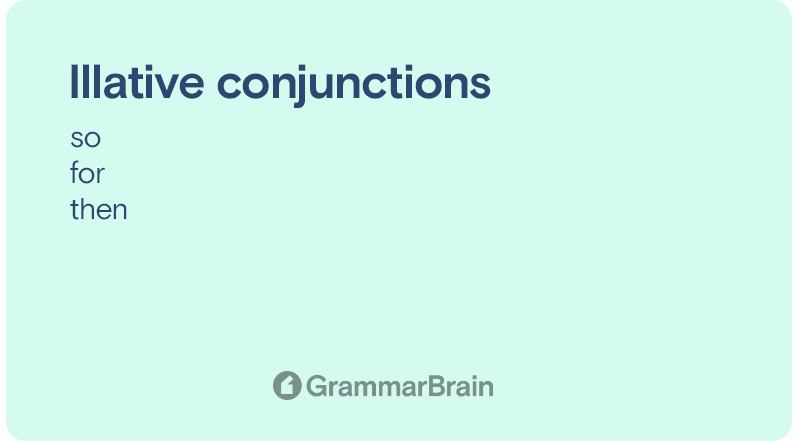
Illative conjunction
Illative conjunctions illustrate an inference or observation. Authors can indicate the outcomes of a prior action using illative conjunctions. These include:
- so
- for
- then
Examples:
- It is raining buckets, so Mary did not go to the party.
- Mary did not go to the party for it was raining buckets.
- I first finished my assignment, then the teacher instructed me to show it to the entire class.
Coordinating conjunctions: Examples
The key coordinating conjunctions used in the English language are widely known by the acronym FANBOYS. They are “for,” “and,” “nor,” “but,” “or,” “yet,” and “so.”
For
It provides an explanation of a purpose or reason, usually in the form of two distinct sentences.
Example:
Styles did not come to the recital yesterday for he was sick.
And
And is a coordinating conjunction that adds one element, like a noun, adjective, clause, phrase, or verb, to another.
Example:
I will go to the supermarket today and buy the peaches.
Nor
Though used less frequently, “nor” functions as the link between two opposing (negative) notions. It connects a negative thought from the first sentence with another negative thought.
Example:
I do not like going to parties, nor do I like dancing.
But
The conjunction “but” contrasts two equally important words, ideas, or phrases.
Example:
I am not really invested in action movies, but I really loved Hitman.
Or
“Or” implies a choice or an alternative. It is used between two clauses or phrases and two similar parts of speech.
Example:
We can go out to eat at your favorite restaurant, or I can cook you dinner.
Yet
“Yet” presents a contrasting concept that logically follows the first idea.
Example:
Lola was harsh to the kids, yet I believe she means well.
So
“So” indicates a consequence, result, or effect of an action mentioned in the preceding clause.
Example:
The kitten was shivering, so I covered him with a blanket.
Points to note:
There are a few things to consider while using coordinating conjunctions:
- A comma must come before the second clause when two separate clauses are joined with coordinating conjunctions.
- When using coordinating conjunctions to join two phrases, a comma is not necessary.
- When coordinating conjunctions are used to join a series of items or multiple nouns, the author can decide whether to use or not use commas.
- Sentences can begin using coordinating conjunctions if the context calls for or permits it.
FAQs
Can sentences start with coordinating conjunctions?
Authors can start their sentences with coordinating conjunctions, but overuse of these conjunctions can make the sentences sound excessively forceful. The key to writing clearly and in a tasteful manner is to use the conjunctions sparingly and in the appropriate places.
Examples:
Oliver did not like drinking, nor did he care for loud music. But he did love Nellie. And she wanted to go clubbing.
What is the difference between coordinating conjunctions and conjunctive adverbs?
Conjunctive adverbs are adverbs that join two clauses by transforming the clause they incorporate into an adverbial modifier of the verb in the independent clause. These include accordingly, eventually, consequently, similarly, anyway, moreover, and finally.
Example:
Noah was good at hockey, and similarly, his wife was also good at it.
What are the seven coordinating conjunctions?
For, And, Nor, But, Or, Yet, So.
Can a coordinating conjunction connect two independent clauses?
Yes. When used together, they can help to create clear complete sentences.
What is a subordinate conjunction?
Subordinating conjunctions connect two independent clauses.
Why is it important to use coordinating conjunctions correctly?
The FANBOYS words help to connect thoughts, ideas, and concepts in clear and complete sentence structure.
Do subordinating conjunctions play a larger role in English?
Both coordinating and subordinating conjunctions are found in English quite frequently. They can be found in a compound sentence and formal writing more often than not.
What is the most common coordinating conjunction?
One of the most common coordinating conjunctions in English is the word “and.” Some writing instructors mention that starting a sentence with a coordinating conjunction is considered incorrect.
Sources:
- Merriam Webster – coordinating conjunction – Definition
- Wikipedia – Conjunction (grammar)
- Grammarly – What Is a Coordinating Conjunction?
- Thesaurus.com – What Is A Coordinating Conjunction? Definition & Examples
Inside this article
Fact checked:
Content is rigorously reviewed by a team of qualified and experienced fact checkers. Fact checkers review articles for factual accuracy, relevance, and timeliness. Learn more.
Core lessons
Glossary
- Abstract Noun
- Accusative Case
- Anecdote
- Antonym
- Active Sentence
- Adverb
- Adjective
- Allegory
- Alliteration
- Adjective Clause
- Adjective Phrase
- Ampersand
- Anastrophe
- Adverbial Clause
- Appositive Phrase
- Clause
- Compound Adjective
- Complex Sentence
- Compound Words
- Compound Predicate
- Common Noun
- Comparative Adjective
- Comparative and Superlative
- Compound Noun
- Compound Subject
- Compound Sentence
- Copular Verb
- Collective Noun
- Colloquialism
- Conciseness
- Consonance
- Conditional
- Concrete Noun
- Conjunction
- Conjugation
- Conditional Sentence
- Comma Splice
- Correlative Conjunction
- Coordinating Conjunction
- Coordinate Adjective
- Cumulative Adjective
- Dative Case
- Determiner
- Declarative Sentence
- Declarative Statement
- Direct Object Pronoun
- Direct Object
- Diction
- Diphthong
- Dangling Modifier
- Demonstrative Pronoun
- Demonstrative Adjective
- Direct Characterization
- Definite Article
- Doublespeak
- False Dilemma Fallacy
- Future Perfect Progressive
- Future Simple
- Future Perfect Continuous
- Future Perfect
- First Conditional
- Irregular Adjective
- Irregular Verb
- Imperative Sentence
- Indefinite Article
- Intransitive Verb
- Introductory Phrase
- Indefinite Pronoun
- Indirect Characterization
- Interrogative Sentence
- Intensive Pronoun
- Inanimate Object
- Indefinite Tense
- Infinitive Phrase
- Interjection
- Intensifier
- Infinitive
- Indicative Mood
- Participle
- Parallelism
- Prepositional Phrase
- Past Simple Tense
- Past Continuous Tense
- Past Perfect Tense
- Past Progressive Tense
- Present Simple Tense
- Present Perfect Tense
- Personal Pronoun
- Personification
- Persuasive Writing
- Parallel Structure
- Phrasal Verb
- Predicate Adjective
- Predicate Nominative
- Phonetic Language
- Plural Noun
- Punctuation
- Punctuation Marks
- Preposition
- Preposition of Place
- Parts of Speech
- Possessive Adjective
- Possessive Determiner
- Possessive Case
- Possessive Noun
- Proper Adjective
- Proper Noun
- Present Participle
- Prefix
- Predicate



